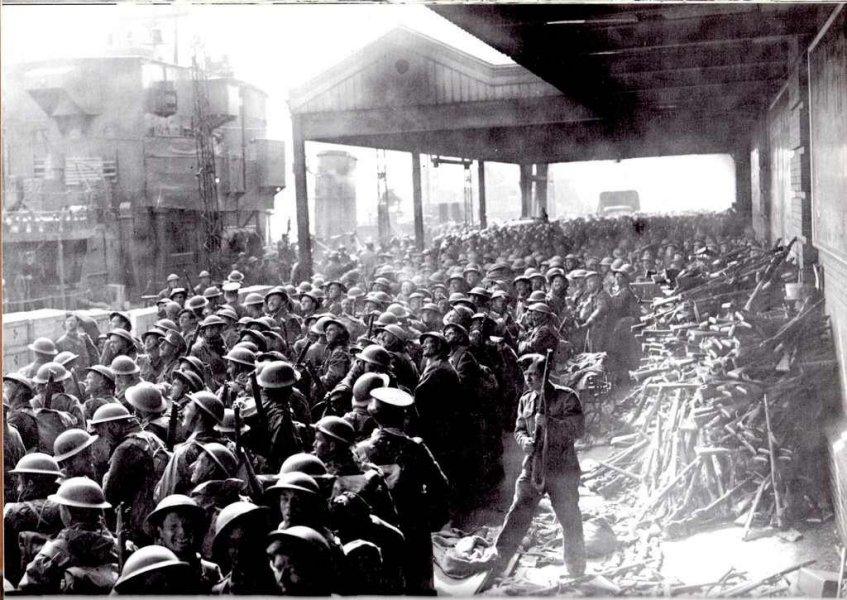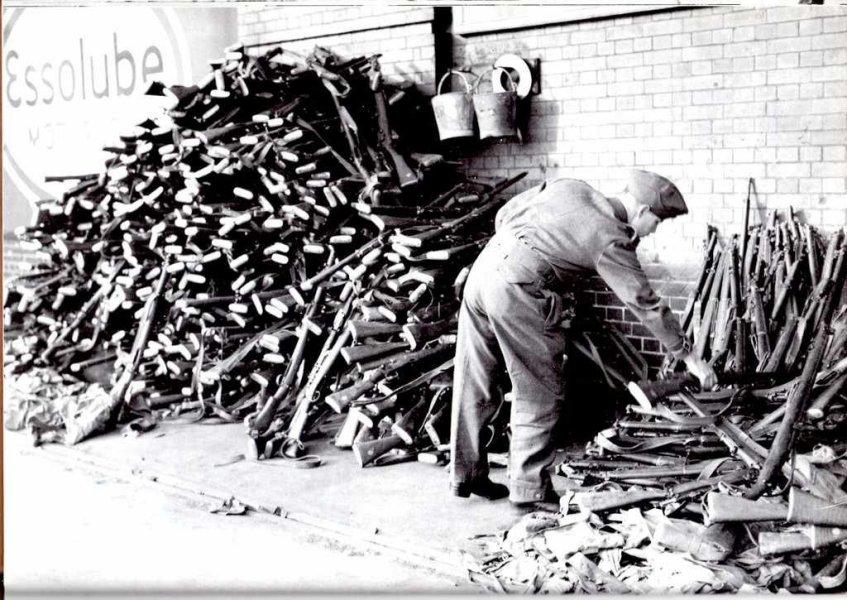-
Legacy Member

Lee Enfield No.1 Mk.III Rifles used during WW2
-
-
04-21-2012 01:16 AM
# ADS
Friends and Sponsors

-
-
The Following 2 Members Say Thank You to Thunderbox For This Useful Post:
-
-
Advisory Panel


Canada , as likely you know, started into World War Two with the SMLE also. These were remaining rifles from WWI stocks, kept in operational condition for the 20 years of "peace".
, as likely you know, started into World War Two with the SMLE also. These were remaining rifles from WWI stocks, kept in operational condition for the 20 years of "peace".
The SMLE was never manufactured in Canada; our rifles were nearly ALL of British manufacture. As far as I can tell, they were surplussed immediately after the war.
manufacture. As far as I can tell, they were surplussed immediately after the war.
Beginning in 1941, Canada turned out large numbers of the new Number 4 Rifle at the Small Arms Limited factory at Long Branch (Toronto) Ontario. Some of these went to arming Canadians, many went to Britain..... and enough were dropped and delivered (night flights with Lizzies and Mitchells) into Occupied Europe, so many, in fact, that many Resistance groups referred to the Number 4 Rifle as "the Canadian rifle". Number 4 production continued into the middle 1950s at Long Branch and was revived years later for the EAL rifle under the new name.
But for the first two years of the Second War, what Canadians used were the old SMLEs, P-17s we scrounged from those awful Americans (good neighbours, those guys!) and our remaining stocks of old Ross Rifles, surely the single most-unjustly-maligned Service rifle ever built.
BTW, when BSA began to manufacture those WW2 SMLEs, they had the ONLY fully-operational rifle factory in the U.K.
Britain learned their lessons well during the Second War. The current SA-80 is all-steel construction because Britain can make that rifle even if they are completely cut off from the rest of the world..... as they very nearly were in 1940 - 42.
.
-
-
Legacy Member

aaaaaaaaaaahhhhhh.... I think the UK has no operating arms factories left to mass produce rifles I am sure they could tool up make stens though....
has no operating arms factories left to mass produce rifles I am sure they could tool up make stens though....
-
-
Legacy Member

Ross's misjudged?
Smellie: Are you suggesting all the written comments about the Ross being a horrible failure as a military rifle are innacurate? When I look at my Ross I can visualize the interrupted thread bolt being easily siezed with crud, plus it still has the original unaltered bolt that can be assembled as a reward aimed projectile. Not being critical of your comment I'm just curious!
-
-
Legacy Member

Thanks for the replies guys, very informative. I'd love to find one of those BSA dispersal rifles someday.
-
-
Contributing Member


Please keep it on subject, the OP deserves our full attention, if you have nothing, say nothing.
-
-
FREE MEMBER
NO Posting or PM's Allowed

Prior to 1943, the SMLE Mark III/III* rifles saw heavy service in the Norwegian , French
, French , North African, Middle Eastern (Iraq), Mediterranean, and Italian
, North African, Middle Eastern (Iraq), Mediterranean, and Italian campaigns in Europe and seemed to have been the predominate rifle to be issued in those theaters throughout the war. I believe I once saw a figure of 200,000 SMLE rifles lost in the Norwegian and French campaigns of 1940 with another 50,000 or so SMLE's lost in the Far East in Malayan campaign of spring 1942. Some Canadian
campaigns in Europe and seemed to have been the predominate rifle to be issued in those theaters throughout the war. I believe I once saw a figure of 200,000 SMLE rifles lost in the Norwegian and French campaigns of 1940 with another 50,000 or so SMLE's lost in the Far East in Malayan campaign of spring 1942. Some Canadian units landed at Dieppe still carrying the SMLE rifle, though many collectors incorrectly assume they were all armed with new No.4 rifles. The No.4 rifle was issued in large numbers to British
units landed at Dieppe still carrying the SMLE rifle, though many collectors incorrectly assume they were all armed with new No.4 rifles. The No.4 rifle was issued in large numbers to British forces in the ETO beginning in 1943, with small numbers of the No.4 on issue in the '43-'45 Italian campaign and in the latter stages of the Burma campaign '44-'45. Otherwise, it was the SMLE which still soldiered on with New Zealand, Australian
forces in the ETO beginning in 1943, with small numbers of the No.4 on issue in the '43-'45 Italian campaign and in the latter stages of the Burma campaign '44-'45. Otherwise, it was the SMLE which still soldiered on with New Zealand, Australian and Indian and other Commonwealth units during the war years. Do you detect a pattern there?!!
and Indian and other Commonwealth units during the war years. Do you detect a pattern there?!!
Last edited by barbarossa; 04-23-2012 at 08:48 PM.
-
Legacy Member

Back on topic as per Muffet.2008 timely reminder:
Establishing the losses in Enfield Rifles in May/June 1940.
in May/June 1940.
There is a great deal of variation in the reported numbers. The highest I have seen shows a loss of 300,000 small arms, which would include rifles, light machine guns, anti-tank rifles, Vickers MMG, including vehicle mounted guns and pistols. We are concerned with the figures of rifles: A careful reading of the sources I have seen regarding the losses incurred in this period indicates that the total of rifles lost was on the order of 90,000, not the 200,000 otherwise discussed above or the 300,000 discussed in Churchill’s famous appeal to Roosevelt in June of 1940.
Starting with the numbers of troops in France:
At the end of April 1940 the reported strength in France was ~395,000 men in the BEF, of which 130,130 were support troops. The total losses in the battle of France/Belgium was around ~68,000 plus of which ~40,000 were captured, with the numbers of evacuated troops being around 342,000 from Dunkirk/ LaHavue/ Cherbourg/ few other small ports
was around ~68,000 plus of which ~40,000 were captured, with the numbers of evacuated troops being around 342,000 from Dunkirk/ LaHavue/ Cherbourg/ few other small ports
The loss of rifles seems to have occurred in two primary areas:
1) Losses in the evacuation of Belgium at Dunkirk
2) Losses of depots in northern France, especially around the Cherbourg area
Now the British troops present at Dunkirk had recently gone up into Belgium, after May 10th , it was the end of May when evacuated. As such I very much doubt any forward ordnance depots were established. The numbers of rifles lost in Belgium then almost all would have come as a result of troops leaving their arms behind, few of which would have been left in operational condition. In the case of the depots in northern France, it is likely the Germans captured a number of operational rifles.
In any case the final figures I have seen was something like this:
Rifles lost in May June 1940: slightly over 90,000 (do not recall exact figure)
Bren Guns lost: around 8,000
Now you might reply with the figure given by by Winston Churchill, that of 300,000 small arms. He used that figure when he was appealing to Roosevelt to supply arms in June 1940. I would have been before the final reckoning of losses occurred. It was not an unreasonable guess, as the losses in heavy equipment were very high: I did a quick google check and here is what I came up with in regard to the heavy weapons:
Shipped to France (September 1939–May 1940) Consumed and expended in action or destroyed or left behind Brought back to England
Guns 2,794 2,472 322
Vehicles 68,618 63,879 4,739
Motor Cycles 21,081 20,548 533,
Ammunitions (tons) 109,000 76,697 32,303
Supplies and Stores (tons) 449,000 415,940 33,060
Petrol (tons) 166,000 164,929 1,071
So given they sent over to France ~ 410,000 men, it was not unreasonable to assume the losses in small arms would have been as high as 75 to 90 percent, given the losses in heavy arms and trucks were on the order of 90 percent. But as other sources have indicated, the evacuated men for the most part came off the beaches and channel ports with their personally assigned small arms. It was the crew served and larger arms that were lost, dumped or thrown overboard to make room for men in the ships. In essence the 300,000 figure was a first order cut, of the expected worst case figure and includes all small arms, not just rifles.
As an independent verification of this let us consider how many arms the Germans culled from the pile of refuse left behind. I cannot recall the exact source but I recall reading that a year or two later the Germans had the equivalent of 4 divisions worth of Enfield rifles, which at the standard rate for a German infantry division when this figure was reported would have been around 44,000 to 48,000 rifles. This figure was I believe reported sometime around 1942to early 1943 when the Germans were equipping units for use in Yugoslavia
infantry division when this figure was reported would have been around 44,000 to 48,000 rifles. This figure was I believe reported sometime around 1942to early 1943 when the Germans were equipping units for use in Yugoslavia against Tito and the use of the English arms was considered. That figure would be very consistent with the figures of 90,000 rifles lost, plus those arms captured in the battle for Greece (losses unknown). For the most part rifles left at Dunkirk would have been disabled. It is only the rifles taken off the dead and a few battlefield surrender rifles that would be in working order, plus those arms pulled from the depots established in the Normandy area. That there were depots in the Cherbourg/ LaHavue area is also established, though I have no recollection of the numbers of arms in the depots.
against Tito and the use of the English arms was considered. That figure would be very consistent with the figures of 90,000 rifles lost, plus those arms captured in the battle for Greece (losses unknown). For the most part rifles left at Dunkirk would have been disabled. It is only the rifles taken off the dead and a few battlefield surrender rifles that would be in working order, plus those arms pulled from the depots established in the Normandy area. That there were depots in the Cherbourg/ LaHavue area is also established, though I have no recollection of the numbers of arms in the depots.
The figures above are approximate, I am going off of memory except for the table above which I took from an on line book.
-
-
Advisory Panel


-
soldiers fighting in Europe and North Africa during WW2. As I understand it, the SMLE was standard issue in the European Theatre from the start of the war, through N. Africa, and was gradually replaced by the No.4 Mk.I during the invasions of Sicily and Italy
.
or Ishapore SMLEs I've come across.















 PM
PM












